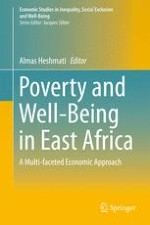2016 | OriginalPaper | Chapter
10. Multidimensional Measure of Poverty in Ethiopia: Factor and Stochastic Dominance Analysis
Authors : Mekonnen Bersisa, Almas Heshmati
Published in: Poverty and Well-Being in East Africa
Publisher: Springer International Publishing
Activate our intelligent search to find suitable subject content or patents.
Select sections of text to find matching patents with Artificial Intelligence. powered by
Select sections of text to find additional relevant content using AI-assisted search. powered by
